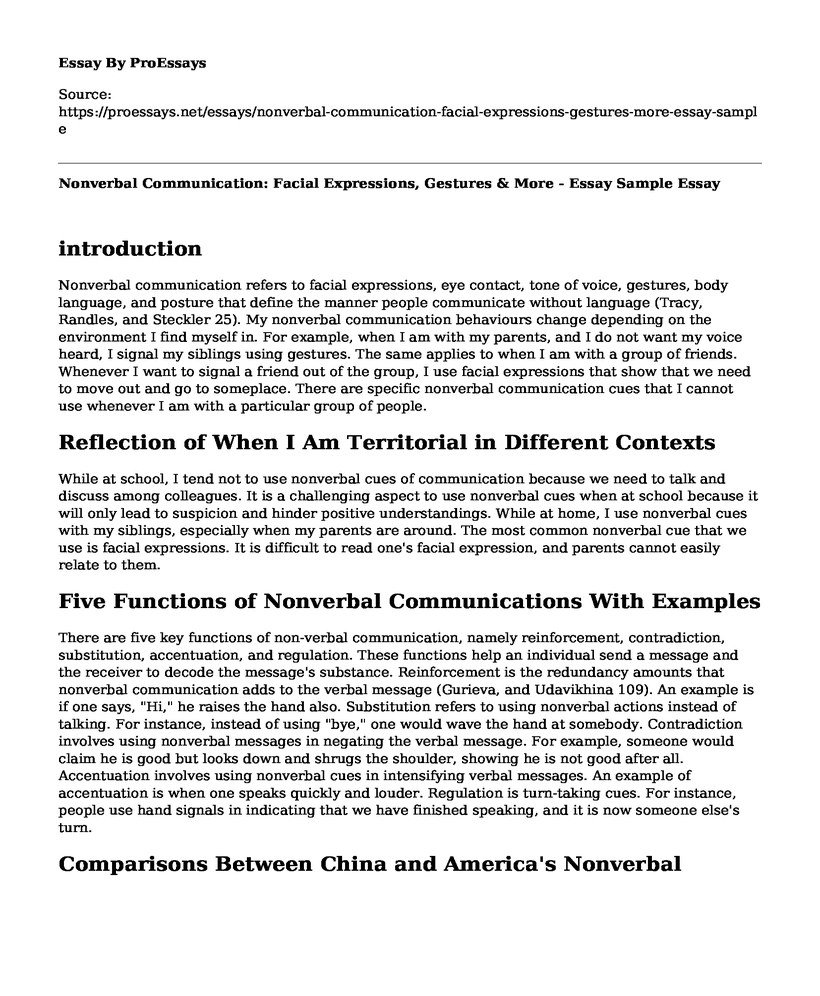introduction
Nonverbal communication refers to facial expressions, eye contact, tone of voice, gestures, body language, and posture that define the manner people communicate without language (Tracy, Randles, and Steckler 25). My nonverbal communication behaviours change depending on the environment I find myself in. For example, when I am with my parents, and I do not want my voice heard, I signal my siblings using gestures. The same applies to when I am with a group of friends. Whenever I want to signal a friend out of the group, I use facial expressions that show that we need to move out and go to someplace. There are specific nonverbal communication cues that I cannot use whenever I am with a particular group of people.
Reflection of When I Am Territorial in Different Contexts
While at school, I tend not to use nonverbal cues of communication because we need to talk and discuss among colleagues. It is a challenging aspect to use nonverbal cues when at school because it will only lead to suspicion and hinder positive understandings. While at home, I use nonverbal cues with my siblings, especially when my parents are around. The most common nonverbal cue that we use is facial expressions. It is difficult to read one's facial expression, and parents cannot easily relate to them.
Five Functions of Nonverbal Communications With Examples
There are five key functions of non-verbal communication, namely reinforcement, contradiction, substitution, accentuation, and regulation. These functions help an individual send a message and the receiver to decode the message's substance. Reinforcement is the redundancy amounts that nonverbal communication adds to the verbal message (Gurieva, and Udavikhina 109). An example is if one says, "Hi," he raises the hand also. Substitution refers to using nonverbal actions instead of talking. For instance, instead of using "bye," one would wave the hand at somebody. Contradiction involves using nonverbal messages in negating the verbal message. For example, someone would claim he is good but looks down and shrugs the shoulder, showing he is not good after all. Accentuation involves using nonverbal cues in intensifying verbal messages. An example of accentuation is when one speaks quickly and louder. Regulation is turn-taking cues. For instance, people use hand signals in indicating that we have finished speaking, and it is now someone else's turn.
Comparisons Between China and America's Nonverbal Behaviours
In China, when one wants to call a taxi on the streets, he or she waves the arms from one side to another. However, in the United States, most people face the taxi, make a fist without the thumb, and move it around. For gestures, both American and Chinese use nod of the head up and down to acknowledge "yes" and shake the head from one side to another to say "no." in relation to eye contact, Chinese believe that it is weird looking at someone for a long time, and they tend to avoid eye contact. In the United States, people value eye contact to show that they are not lying. In Asian culture, people like living together, and it unites their relationships and friendships (Maggs 1735). In the United States, people are more individualistic. In China, when someone is invited to a party, he must be there earlier or on time. However, in the United States, when one is invited, he should be there late. What these differences show is that cultures have evolved to define what qualifies and what does not qualify as nonverbal cues of communication.
Five Universals in Nonverbal Communication
The five universal behaviours of nonverbal communication include paralanguage that defines the information passed through vocal aspects such as sighs and yawns. Spoken variables, including pitch, intensity, speech disturbances, and tempo, are paralanguages. The second universal aspect is kinesics that are bodily gestures and movements, including the postural adjustments, movements through space, and postures (Maggs 1734). Proxemics defines the use and structure of spatial considerations and space whenever interacting with other people. The facial expressions help in displaying mood or emotion. The final aspect is visual behaviour that defines the visual interactions that signal involvement with another person to show flirtation, attraction, feedback, and power.
Works Cited
Gurieva, Svetlana Dzakhotovna, and Ulyana Andreyevna Udavikhina. "Negotiating Styles in Situation of Limited Resources and Ambiguity: "Short" and "Long" Communications." Mediterranean Journal of Social Sciences 6.4 (2015): 109. Retrieved from https://www.mcser.org/journal/index.php/mjss/article/viewFile/7058/6761
Maggs, Jill Carol. "One Classroom, Two Cultures: The Experiences of Chinese Students in an American College." (2018). Retrieved from https://infonomics-society.org/wp-content/uploads/iji/published-papers/volume-11-2018/One-Classroom-Two-Cultures.pdf
Tracy, Jessica L., Daniel Randles, and Conor M. Steckler. "The nonverbal communication of emotions." Current opinion in behavioral sciences 3 (2015): 25-30. Retrieved from http://ubc-emotionlab.ca/wp-content/files_mf/tracyetalcurrentopinion2015.pdf
Cite this page
Nonverbal Communication: Facial Expressions, Gestures & More - Essay Sample. (2023, Mar 09). Retrieved from https://proessays.net/essays/nonverbal-communication-facial-expressions-gestures-more-essay-sample
If you are the original author of this essay and no longer wish to have it published on the ProEssays website, please click below to request its removal:
- Cauldron's Opinion on Barbie Conventions
- Approaches to Ethical Decision Making Essay
- Communication in Organizations Paper Example
- Critical Analysis Essay on Manacles of Madness: Haywood's The Distress'd Orphan
- Americanization of the Native Indian Tribes Paper Example
- Essay on Creating Meaningful Communication: Establishing Effective Communication Policies
- Investigating Cost Behavior With Community Social Capital - Essay Sample







